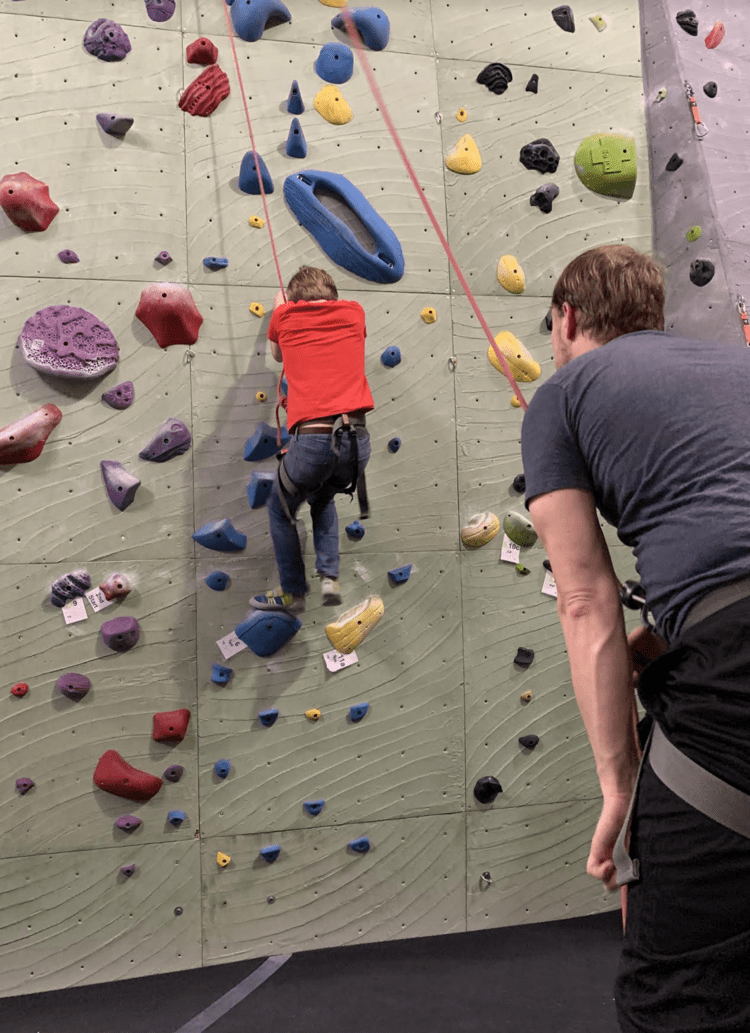My brother and sister-in-law recently gifted our family an afternoon at a climbing gym. Prior to this, my most intense climbing experience had occurred on a rope in my elementary school’s multipurpose room with my first-grade classmates below, craning their necks upward to see if I reached the top.
As a more experienced climber, my brother volunteered to be our belayer, the person who stands at the base of the rock wall and holds the rope for the climber. Each of us took our turn stepping up to the wall, and as he tied the rope to our harnesses, we listened to his lesson on how to tie the knot, how to check the knot, and how to make sure the knot was secure. He also taught us how to communicate with the belayer while we climbed. “When you’re ready to go higher,” he said, “yell down to me, ‘On belay!’ And if I’m ready, I’ll give you the ok to climb by yelling back to you, ‘Climb on!’”
As we grew more comfortable with our climbing skills, we ventured off to try different walls and made use of the gym’s auto-belays, which would automatically counter the climber’s weight so there was no need for a human belayer. We were about halfway through our time at the climbing gym when I decided to show off my new skills to my daughter. I hooked my harness to an auto-belay and made quick work of my chosen wall before repelling down to the ground near my daughter. As I unhooked the clip from my harness, I turned to proudly face my thirteen-year-old, expecting her to be in total awe of what she had just witnessed. Instead, she said, “You know you’re just supposed to climb one color, right?”
Oh.
As it turns out, those walls filled with multi-colored plastic blobs that look like old chewing gum stuck to a desk are not there just to add a pop of color to an otherwise pretty gray place. I came to learn that not only can different colors of “holds” (the technical term for “plastic blobs”) indicate the level of difficulty, but the holds are arranged up a wall in a particular pattern – or route – in order to challenge climbers in different ways. Additionally, my brother informed me later as we observed an employee drilling new holds into a wall, that experienced climbers can tell what moves a route expects a climber to use based on the way the holds are arranged. The most experienced climbers evidently can read a rock wall like a map and know exactly what their bodies and limbs need to do in order to move successfully up the wall. (It is worth noting that the way I was climbing is referred to as “rainbow style,” which is hard to think of as a bad thing.)
In my current work as an educational researcher, consultant, and co-founder of VECTOR Virtual Coaching, I am blessed to work with some amazing educators who coach teachers and on-site instructional coaches in a virtual setting. Our coaching model is similar to many other coaching models in that we support our virtual coaches to ask strategic questions, help educators set meaningful, measurable, data-responsive goals, and work toward those goals using evidence-based strategies and high-leverage practices that will improve student learning.
As I reflected on my family’s time at the gym, it occurred to me that a few key learnings from my climbing experience apply quite nicely to the work our VECTOR coaches do every day.
1. Good coaches, like good belayers, hold a unique perspective.
Our “coachees” in the VECTOR program work in schools as classroom teachers instructional coaches, and administrators. These teachers and coaches are busy. They are always thinking, always “on.” They rarely sit down. They answer approximately eight thousand questions a day. They are machines. The trouble with being this dedicated, however, is that sometimes when a person is this busy, it’s difficult to see a situation differently, or from a perspective other than the one in which a person finds herself, for example, trying to figure out how to arrange the desks of 30 first-graders so that they are six feet apart.
As an inexperienced climber, all I was looking for was my next, obvious, most necessary move. But my belayer brother was able to see the entire wall as I climbed. He shared my excitement when I made a big, daring move. He helped me make tiny adjustments to my form – “Keep your body closer to the wall” – so that I’d be more successful. He encouraged me to let go of all the holds at one point so that my hands could rest, and I hung in the air suspended from the rope he was holding below me until I signaled to him that I was ready to “climb on.” Likewise, as an experienced climber who had tackled a wide variety of different climbing challenges before, he was able to see the wall in a different way than I did.
In a sense, our VECTOR coaches serve as belayers for their coachees. As professional educators outside of the schools and districts their coachees are working in, they are able to see systems through lenses that are broad, fresh, and unbiased. They encourage successes, both miniscule and monumental, and they help their coachees make adjustments that will lead to better learning environments for students. Sometimes, they even help their coachees to let go of long-held beliefs and practices that are not serving them or their students so that they can take a breath, figure out their next move, and get back to doing the work they love.
2. The easiest move may not the best move.
It’s easy for busy educators working in schools to move through their day from one class to the next, one task to the next, totally focused on their next move and not much beyond that. Education in practice is often literally “boots on the ground” work in the sense that well-educated professionals build habits over time that help them navigate through challenges that could derail students. That work is important, no doubt. However, it is also essential that busy educators slow down once in a while and take time to think strategically about how they might be more effective in their work.
When I was climbing “rainbow style,” I was entirely focused on getting up that wall one hold at a time. It didn’t matter to me that I wasn’t challenging myself to stick to only the green holds, or that I wasn’t experiencing the route as the designers had intended. Once I learned to see only the holds in the route I was intent on climbing, I began to think differently about how I might progress up the wall, and the new moves I would have to learn in order to be successful.
Our VECTOR coaches work closely with coachees to examine their current practice and how it influences or could influence others. This involves thinking critically about the “moves” they regularly engage in, and the ways those moves help or hinder their work. A great coach can help a coachee filter out the noise and see a path that may be challenging, but also may be better aligned with a coachee’s professional goals.
3. Sometimes you can’t clearly see the things you desperately need to see.
Climbing gym route-builders are tricky. I learned this when I was about twenty feet off the ground, trying to stick to the dark blue holds. My brother shouted up to me, “The hold for your next move is around the corner!” How in the world was I supposed to know that? Seriously.
VECTOR coaches have several ways to help their coachees gain a broader and move objective view of their work. One simple way they do this is by having their coachees upload recordings of their teaching or coaching sessions to an online coaching platform. From there, the VECTOR coaches and coachees are able to work through conversational protocols to gain a clearer view of the coachee’s current “route” and what moves might be obvious that were unclear when the coachee was in the thick of the action.
Another effective means for helping especially teacher coachees gain a broader view of their work is by engaging together in a thoughtful examination of student work samples. Student work can tell educators a great deal about which skills are progressing and which are not, and it can be an excellent way for coachees to track goal achievement. If a teacher has a goal for students to write more detailed sentneces, there is no better way to track progress for that goal over time than to look at the students’ work, and how their writing changes in response to the teacher’s instruction focused on including more detail in sentences.
In the coming months, educators throughout the country will be working to figure out their next moves for returning to school, planning for another potential multi-week disruption to teaching and learning, and working with families and community members to prepare for what may be currently uncertain or unclear – the next “hold” around the corner. We believe strongly that even the most seasoned professionals can benefit from high-quality coaching. We also know that coaching can come in a variety of forms and from a variety of people. In whatever ways educators seek support for the path ahead, we remain optimistic that these experiences will help them to gain new perspectives, a better vision for the next right move, and greater clarity about where they have been and where they wish to go. On belay!

